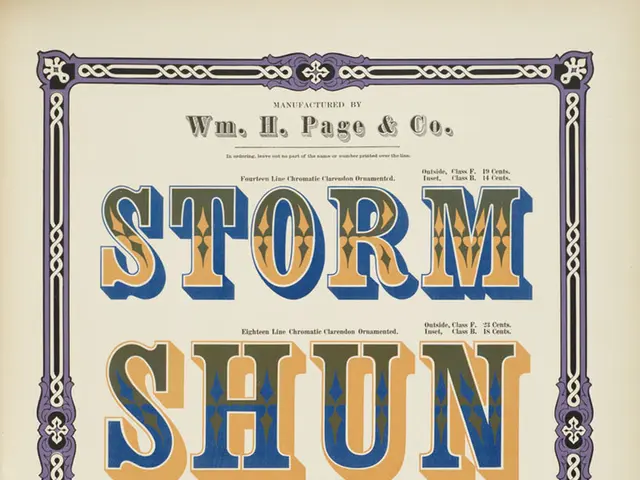The essence of autonomous filmmaking: A deep dive into the realm of Independent Cinema
Indie films, or independent films, are moviemaking marvels produced outside the grasp of major studio systems. These cinematic creations prioritize artistic expression and unique storytelling over commercial success (1). With pocket-sized budgets and ingenious filmmaking approaches, indie flicks have been the launchpad for renowned directors such as Quentin Tarantino and Greta Gerwig (1).
So, what makes these indie darlings so special? Let's delve into their defining characteristics, history, and the impact they've made on the film industry (1).
The Indie Spirit was Born!
Indie filmmaking has been around for nearly as long as cinema itself, but it wasn't until the mid-20th century that the indie film movement truly took flight (1). Pioneers like John Cassavetes championed low-budget, personal storytelling, paving the way for future independent filmmakers (1).
The 1990s marked a monumental turning point for indie cinema. Filmmakers such as Tarantino, Smith, and Rodriguez demonstrated that compelling narratives could be spun on shoestring budgets and still find mass appeal (1). Festivals like Sundance provided a larger audience, while advances in digital filmmaking made high-quality production more accessible (1).
Today, indie films reach a broader demographic, but they continue to be defined by creative freedom, innovative filmmaking techniques, and resourceful storytelling (1). They remain the antithesis of the traditional studio system.
The Indie DNA
Indie films are more than just low-budget productions; they embrace creative freedom, unconventional storytelling, and frugal filmmaking (1). Studios typically focus on large-scale productions with mass-market appeal, whereas indie flicks take a different approach (1).
Some defining characteristics of indie films include:
- Small budgets, resulting in smaller crews and minimal sets. This forces filmmakers to be resourceful with problem-solving and adjusting to constraints (1).
- Creative freedom. Indie directors aren't bound by studio oversight, enabling them to explore unique stories, take artistic risks, and experiment with unusual filmmaking techniques (1).
- A focus on character-driven narratives and niche topics that may not interest major studios, resulting in intimate, heartfelt storytelling (1).
- Indie financing methods, such as independent investors, grants, crowdfunding, or self-financing (1).
- Limited or alternative distribution, often through film festivals, streaming platforms, or limited theater releases (1).
While some indie films find mainstream success, their primary defining characteristic lies in their independent spirit - valuing artistic expression over commercial constraints (1).
Curious about the director's role? Check out our detailed breakdown in this blog post!
The Indie Filmmaking Approach
Given limited resources, indie filmmakers rely on their ingenuity to bring their vision to life (2). These constraints often lead to unique and unmatched artistic choices, setting indie films apart from their blockbuster counterparts.
Making Every Dollar Count
Indie creators stretch every dollar, relying on creative problem-solving to manifest their vision (2). Simple tools, like real-world locations, borrowed equipment, and the involvement of friends and family as cast and crew help keep costs low (2).
Smartphone Filmmaking & Practical Lighting
Affordable consumer cameras, like smartphones and DSLRs, are often employed for shooting (3). Apps like Filmic Pro give filmmakers control over focus, exposure, and frame rate (3). Natural light, street lamps, and household fixtures frequently replace professional lighting equipment, contributing to the raw, unfiltered aesthetic that defines many indie films (2).
Practical Locations
Rather than constructing elaborate sets, indie filmmakers frequently shoot in authentic locations such as apartments, coffee shops, and city streets (2). These settings save money while adding authenticity to the stories being told (2). However, filming in public spaces comes with its own set of challenges, such as securing permits and dealing with unexpected interruptions (2).
Handheld Cinematography & Editing
Indie directors often employ handheld cameras, unconventional framing, and long, unbroken takes to enhance intimacy and immersion (2). Editing decisions, like jump cuts, split screens, and mixed media, can also help form a film's distinctive visual language and turn budgetary constraints into artistic strengths (2).
The DIY ethos of indie filmmaking fosters innovation and showcases the idea that compelling storytelling isn't confined to multi-million-dollar budgets (2).
The New Wave of Indie Innovation
Indie filmmaking has always thrived on resourcefulness, and as technology advances, the possibilities are more promising than ever (3). The barriers to entry are at a record low, making it simpler for any storyteller to bring their vision to life (3).
Mobile Filmmaking
Smartphones, now considered a serious tool for indie creators, have paved the way for innovative productions (3). Films like "Tangerine" and "28 Years Later" demonstrate that high-quality storytelling can be achieved on shoestring budgets with the aid of smartphones (3).
Budget-Friendly Gear
In addition to smartphones, inexpensive gear like the Blackmagic Pocket Cinema Camera and Sony FX3 has revolutionized indie production (3). Compact cameras, gimbals, drones, and affordable LED lighting kits equip indie filmmakers with professional-grade tools at a fraction of Hollywood's cost (3).
AI & Digital Tools
AI-driven software like Runway ML and Descript have found a home in indie filmmaking, offering new ways to streamline the creative process and speed up post-production (3). Text-to-image generators help filmmakers visualize scenes before shooting, while voice AI tools can assist in creating temporary dialogue tracks before actors step in (3).
Crowdfunding & Community Support
Platforms like Kickstarter, Indiegogo, and Seed&Spark empower indie filmmakers to fund their projects directly through their audience (3). Social media enables creators to build hype around their films, find collaborators, and connect with a global network of indie enthusiasts (3).
The Future is in Your Hands
With all these tools at their disposal, aspiring filmmakers are encouraged to pick up their cameras and start shooting (3). Whether filming with a smartphone or a professional camera, today's world is ripe for new voices and fresh perspectives (3). So, dive in and make your vision a reality!
Jumpstart your indie project with our website's free screenwriting software today. With tools designed for creators at any level, our website gives you the power to format, plan, and collaborate - all with a budget-minded approach (3). Get started now!
Authenticity and Intimate Storytelling in Indie Films
One of the key elements that sets indie films apart is their commitment to authenticity. These movies delve deep into personal, raw stories, focusing on characters, emotions, and relationships (2). Indie directors aren't burdened by studio expectations or box office pressures, making it possible to create nuanced and genuine storytelling (2).
Take the critically acclaimed "Lady Bird" for example, with its portrayal of a mother-daughter relationship that's both deeply personal and universally relatable (2). Similarly, "The Florida Project" captures the unfiltered life of childhood in poverty and the resilience of its characters (2). These films forego elaborate settings and high-budget production values to concentrate on the emotional core of the story (2).
Indie filmmakers embrace raw, imperfect, and vulnerable storytelling, leading to intriguing narratives that resonate with viewers (2).
Looking to create your own documentary film? This blog post provides a comprehensive walkthrough to get you started!
Indie Film Inspirations: Contemporary Examples to Watch
If you're eager to explore the world of indie filmmaking, these contemporary examples are an excellent starting point (4). Each film offers a unique perspective on storytelling, technique, and creativity, providing valuable insights for aspiring filmmakers.
Must-Watch Indie Films
- "Parasite" (2019) - Directed by Bong Joon-ho, this Oscar-winning film seamlessly blends humor with sharp social commentary (4). Its popularity demonstrates how indie films with niche focuses can still resonate with global audiences (4).
- "The Farewell" (2019) - Written and directed by Lulu Wang, this semi-autobiographical story about a family grappling with cultural differences and the impending loss of a loved one showcases the beauty of intimate, personal storytelling (4).
- "Whiplash" (2014) - Damien Chazelle's rapid-fire drama about an ambitious drummer and his demanding teacher demonstrates the power of smaller budgets and a singular vision to generate critical success (4).
- "Get Out" (2017) - Jordan Peele's directorial debut combines social commentary with psychological thriller, illustrating how indie films can use genre conventions to make profound statements on race and identity (4).
These diverse films share a common spirit of independence, risk-taking, and a passion for crafting engaging stories (4). By embracing new technologies, indie directors continue to push boundaries and explore fresh narrative landscapes (4).
Want more indie films to add to your must-watch list? This Esquire article delivers 40 recommendations to explore!
The Future of Indie Film
Indie films have carved out a significant subgenre in cinema by embracing independent visions and taking creative risks (1). Here are some predictions about the future of indie filmmaking:
More Diverse Storytelling
With platforms like Sundance championing underrepresented voices, indie films are becoming more inclusive and reflective of varied cultures, perspectives, and experiences (1).
Leveraging Mobile Technology
Filmmakers are turning to mobile technology to create powerful narratives on a shoestring budget (3). In collaboration with user-friendly editing apps, smartphones provide a legitimate tool for making impactful films (3).
Self-Distribution Options
Streaming platforms and digital distribution tools enable indie filmmakers to bypass traditional distribution hurdles and share their work with broader audiences (1). Self-distribution empowers creators to connect directly with global viewers, removing the need for middlemen (1).
Bolder Experimentation
Expect indie directors to continue pushing boundaries with genre, structure, and storytelling techniques (1). From nonlinear narratives to the blending of film with interactive media, indie filmmakers will continue to challenge conventions and explore new territories (1).
Immersive Experiences
The intersection of technology and filmmaking is bringing new immersive storytelling experiences to the fold (1). Virtual reality projects and interactive films will provide engaging and dynamic viewing experiences for indie film audiences (1).
A New Generation of Filmmakers
Passionate young filmmakers will ride the wave of technology to create a new aesthetic. With their Gen Z perspective, indie cinema will expand, enriching its scope and style (1).
Conclusion
Indie filmmaking, at its core, is fueled by passion. These cinematic creations offer stories that lie outside mainstream norms, presenting authentic, raw, and intimate narratives (2). Financial limitations don't stifle this spirit - they foster it, compelling filmmakers to be inventive with what they have (2).
As studios focus on formulas and reboots, indie directors keep pushing boundaries and challenging assumptions, delivering stories beyond generic escapism (1). They create narratives that invite viewers into emotional journeys, focusing on the human element that blockbuster cinema often overlooks (2).
The future of indie film is bright, and it's being shaped by the dreams and efforts of new filmmakers. Indie cinema will continue to thrive, as long as there are authentic stories waiting to be told (1).
So, dust off your camera, roll tape, and share your vision with the world. The indie spirit is alive and well, and there's never been a more exciting time to join the movement.
Get started on your indie film project with our website's free screenwriting software. With tools designed for creators at any level, our website helps you format, plan, and collaborate - all while saving on production costs (3). Join the future of filmmaking today!
Looking for more helpful resources? Check out these Our Website articles:
- How to Write a Logline [Video and Examples Included]
- Generating Short Film Ideas: 14 Ways to Get the Juices Flowing
- The Screenwriting Portfolio: What You Need & How to Stand Out
Stay up-to-date on indie filmmaking adventures. Follow our website on these social media platforms:
- YouTube
- TikTok
- Bluesky
Authors
- Jenny Fisher - Jenny Fisher is a blogger and published author who now dedicates her time to content management for our website, helping budding filmmakers bring their ideas to life.
- Sherice Griffiths - Sherice Griffiths is a comedy writer-director based in Surrey, England. With a blue belt in Brazilian Jiu-Jitsu, she has placed as a finalist for the BAFTA Rocliffe new writing competition and the Tri-Force UKTV Writers Slam, as well as the semi-finals of the US Screencraft Comedy Competition.
- Indie films are more than budget constraints, they embrace creative freedom, unconventional storytelling, and frugal filmmaking.
- With limited resources, indie filmmakers rely on ingenuity to bring their vision to life, leading to unique artistic choices setting indie films apart.
- Technological advancements have made it simpler for indie filmmakers to create impactful narratives on shoestring budgets, with smartphones now considered a serious tool in indie filmmaking.
- Indie films continue to push boundaries with genre, structure, and storytelling techniques, leveraging AI and digital tools to streamline the creative process and speed up post-production.
- The future of indie film promises more diverse storytelling, self-distribution, bolder experimentation, immersive experiences, and a new generation of filmmakers using technology to create a new aesthetic.








